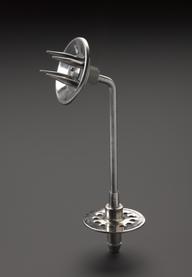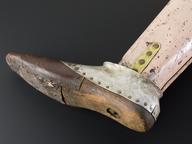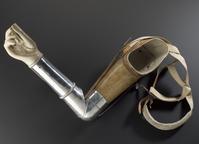

Pair of artificial legs worn by Ed Freeman
- Made:
- 1968-1972 in London, England and Roehampton






Pair of artificial legs, used by Ed Freeman, a child living with impairments caused by thalidomide, made at the Roehampton Limb Fitting Centre, London, 1967-1972
Ed Freeman wore prosthetic legs until he was 10. As he grew, his balance worsened and he often fell over. He was given a crash helmet to wear, to protect his head, but said it was a waste of time and “just made you look a complete nerd”.
Prosthetic or artificial limbs were in part meant to act as reparations for the impairments that thalidomide had caused. They were frequently used as a way of visually “normalising” the bodies of people living with thalidomide impairments. Many question who these supposed improvements were really meant to help. Some children underwent operations to make the prosthetic limbs fit better which could include amputations. Children had little input into these decisions and the trauma of some of these medical interventions is still felt today, both emotionally and physically.
Thalidomide was a compound found in drugs prescribed to people in the late 1950s and early 1960s. Although today it is associated primarily as a treatment for pregnancy related nausea, it was also prescribed to anyone experiencing symptoms of colds, flu, headaches, anxiety, and insomnia. Thalidomide causes nerve damage in the hands and feet of adults, but when taken in early pregnancy it causes impairments such as limb difference, sight loss, hearing loss, facial paralysis, and impact to internal organs. One tablet is enough to cause significant impairments. Researchers later identified that there was a link between the impairment a person is living with, and which day of the pregnancy thalidomide was taken. UK distributors withdrew the drug in 1961 and a government warning was issued in May 1962.
Details
- Category:
- Orthopaedics
- Object Number:
- 2006-23
- Measurements:
-
overall: 530 mm x 300 mm x 200 mm, 3.78 kg
perspex stand: 7 mm x 340 mm x 250 mm, 3.75 kg
- type:
- artificial leg and prosthetic leg
- credit:
- Mr. Eddie Freeman




